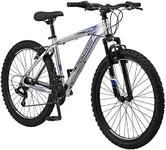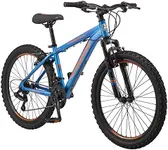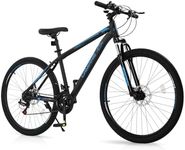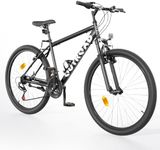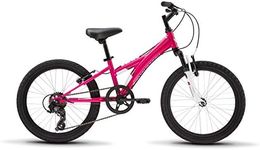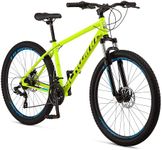Buying Guide for the Best Cheap Mountain Bikes
Choosing the right mountain bike can be a thrilling yet daunting task, especially if you're new to the sport. The key is to understand your needs and match them with the bike's specifications. Mountain bikes come in various types and with different features, each designed to handle specific terrains and riding styles. By focusing on the key specifications, you can find a bike that offers the best performance and comfort for your adventures on the trails.Frame MaterialThe frame material of a mountain bike is crucial as it affects the bike's weight, durability, and ride quality. Common materials include aluminum, carbon fiber, steel, and titanium. Aluminum is lightweight and affordable, making it a popular choice for beginners. Carbon fiber is lighter and offers better shock absorption but is more expensive. Steel is durable and provides a smooth ride but is heavier. Titanium is strong and light but comes at a premium price. For most beginners, an aluminum frame offers a good balance of weight, durability, and cost.
Suspension TypeSuspension helps absorb shocks from rough terrain, making your ride smoother and more comfortable. There are three main types: rigid (no suspension), hardtail (front suspension only), and full suspension (both front and rear suspension). Rigid bikes are lighter and cheaper but less comfortable on rough trails. Hardtail bikes offer a good balance of comfort and efficiency, making them ideal for beginners and cross-country riding. Full suspension bikes provide the most comfort and control on rough terrains but are heavier and more expensive. Choose a hardtail if you're starting out or riding smoother trails, and consider full suspension for more technical and rough terrains.
Wheel SizeWheel size affects the bike's handling and performance. The common sizes are 26-inch, 27.5-inch, and 29-inch. 26-inch wheels are nimble and easy to maneuver, making them suitable for smaller riders or those who prefer a more agile bike. 27.5-inch wheels offer a balance between agility and stability, making them a versatile choice for various terrains. 29-inch wheels roll over obstacles more easily and maintain speed better, making them ideal for long-distance rides and rough terrains. Consider your riding style and terrain when choosing the wheel size; 27.5-inch is a good all-rounder for most beginners.
GearingGearing determines how easy it is to pedal the bike over different terrains. Mountain bikes typically have a wide range of gears to handle steep climbs and fast descents. The number of gears can range from single-speed to 30 or more. More gears provide greater flexibility and make it easier to tackle varied terrain. However, more gears also mean more maintenance. For beginners, a bike with 18-24 gears (2x9 or 3x8 setups) offers a good balance of simplicity and versatility, allowing you to handle most trails without being overwhelmed by maintenance.
BrakesBrakes are essential for safety and control. The two main types are rim brakes and disc brakes. Rim brakes are lighter and cheaper but less effective in wet or muddy conditions. Disc brakes, which can be mechanical or hydraulic, offer better stopping power and performance in all conditions. Mechanical disc brakes are easier to maintain, while hydraulic disc brakes provide more precise and powerful braking. For most beginners, mechanical disc brakes offer a good balance of performance and ease of maintenance, ensuring you can ride safely in various conditions.
Tire WidthTire width affects the bike's grip and comfort. Wider tires provide better traction and cushioning, making them ideal for rough and loose terrains. Narrower tires are lighter and roll faster, suitable for smoother trails and cross-country riding. Common widths range from 2.0 to 2.6 inches. For beginners, a tire width of 2.2 to 2.4 inches offers a good balance of grip and speed, allowing you to handle a variety of terrains comfortably.

